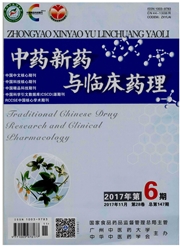

 中文摘要:
中文摘要:
目的观察洋川芎内酯Ⅰ(SEI)对偏头痛大鼠皮层扩展性抑制(CSD)电位及一氧化氮(NO)、降钙素基因相关肽(CGRP)含量的影响,初步探讨其起效机制。方法将SD大鼠随机分为假手术组,模型组,SEI高、中、低剂量组,盐酸氟桂利嗪组,每组6只。除假手术组外,其余大鼠给予蘸有1mol·L^-1氯化钾(KCI)的棉球诱导CSD,并在大鼠顶叶局部放置电极记录偏头痛大鼠在给药前后CSD的波幅以及频率变化,以硝酸还原酶法测定大鼠血浆中NO和CGRP的含量变化。结果除假手术组外,其余各组给予KCI后3min左右诱导出现CSD,表现为双向电位,与模型组比较,SEI中、低剂量组电位幅度虽有降低趋势,但无统计学意义(P〉0.05),SEI高剂量组及盐酸氟桂利嗪组可明显抑制CSD的波幅,差异有统计学意义(P〈0.05)。模型组血浆中的NO、CGRP含量较假手术组显著升高,差异有统计学意义(P〈0.05,P〈0.01),而SEI高剂量组的NO、CGRP及中、低剂量组的CGRP含量较模型组显著下降,差异有统计学意义(P〈0.05,P〈0.01)。结论SEI对偏头痛的治疗作用可能是通过调节血浆中的NO及CGRP含量实现的。
 英文摘要:
英文摘要:
Objective To evaluate the effect of senkyunolide I(SEI) on cortical spreading depression(CSD) and the levels of plasma nitric oxide(NO) and calcitonin gene related peptide(CGRP) in migraine rats. Methods SD rats were randomly divided into five groups, including sham-operation group, model group, and treatment groups treated with SEI( 144, 72 and 36 mg·kg^-1) or flunarizine hydrochloride( 1 mg·kg^-1). Migraine model was established by application of 2-mm-diameter cotton balls immersed with KC1 ( 1 mol· L^-1) to the frontal cortex (3 mm anterior to the Bregma and 3 mm to the sagital fissure) after exposure of the skull. KC1 stimulation evoked CSD potentials (3 mm posterior to the Bregma and 5 mm to the sagital fissure) were recorded by using a homemade copper electrode. After successful modeling, the medicaiton groups were given SEI at the doses of 144, 72 and 36 mg·kg^-1 by intraperitoneal injection. The plasma levels of NO and CGRP were measured by using nitrate reductase method and Iodine^125 ThromboxaneB2 Radioimmunoassay Kit, respectively, Results CSD was induced 3 rain after application of KC1 to the frontal cortex, characterized by two-way electric potential. The potential amplitude was lower in moderate-and low-dose SEI groups than that in the model group of similar to the model group, and high-dose SEI and flunarizine hydrochloride significantly inhibited the amplitude of the CSD (P 〈 0.05 compared with the model group). The levels of plasma NO and CGRP in model group were significantly higher than those in normal group(P 〈 0.05 ), while plasma NO levels and CGRP content in treatment groups considerably decreased(P 〈 0.01 ) compared to those in model group. Conclusion Senkyunolide is effective for treatment of migraine by regulating plasma NO and CGRP contents.
 同期刊论文项目
同期刊论文项目
 同项目期刊论文
同项目期刊论文
 期刊信息
期刊信息
